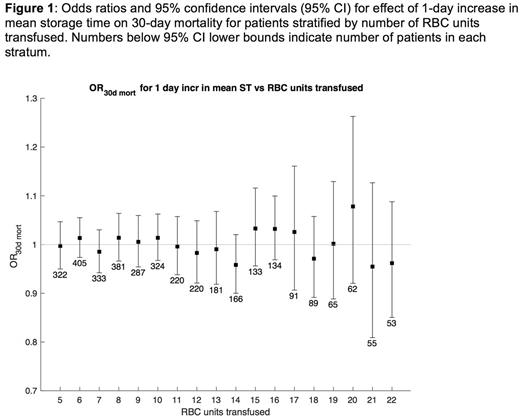Abstract
Background
Clinical trials studying age of transfused red blood cells (RBCs) have found no evidence of benefit from transfusion of fresher RBCs. However, these studies have not included patients requiring massive transfusion for major bleeding, a patient population that may be more susceptible to adverse effects of the RBC storage lesion. Further, no clinical trials have specifically evaluated the safety of transfusing RBCs approaching expiry (30-42 days). We investigated the association between RBC storage time and 30-day mortality in a large cohort of massively transfused patients (5 RBCs within 4 hours, from any bleeding context).
Methods
Using 2007-2015 Australian/NZ Massive Transfusion Registry data from 25 hospitals linked with Australian and New Zealand National Death Index data, we modelled the association between storage time and 30-day mortality in massively transfused patients. Our logistic regression model adjusted for Charlson co-morbidity score, patient age, patient sex, number of RBC units transfused, and bleeding category (cardiothoracic, gastrointestinal, obstetric, surgical, trauma, vascular surgery, or other) with treating hospital as a random-effects grouping variable. Storage time was quantified as the mean storage time of all units each patient received for our primary analysis, and as a binary predictor indicating patients receiving only RBCs older than 30 days for our secondary analysis. As sensitivity analyses, we stratified patients by number of RBC units received and ran our model individually on each stratum containing more than 50 patients receiving equivalent numbers of RBCs in order to eliminate any confounding introduced by comparing patients receiving differing numbers of RBCs. In our stratified sensitivity analyses, in addition to mean storage time of RBC units received by each patient, we tested minimum and maximum storage times of transfused RBC units as predictors.
Results
4127 patients meeting the massive transfusion definition during the study period had RBC age available. Stratifying on number of RBC units transfused resulted in 19 strata containing more than 50 patients (those receiving 5,6,7,...23 RBC units), comprising 3641 patients (88% of study population). In the analysis of the entire cohort together, we found no significant association between mean storage duration and 30-day mortality (ORST=0.99 [95%CI: 0.98 to 1.01]; p=0.42) or patients transfused with only RBCs >30days old and 30-day mortality (ORST>30d=0.85 [95%CI: 0.52 to 1.37]; p=0.49). In our stratified sensitivity analyses, we found no association between mean storage time and 30-day mortality (OR for a 1-day increase in mean storage time [ORmeanST] range = 0.95 to 1.08 with p>0.05 for entire range). We likewise found no associations between maximum and minimum storage times and 30-day mortality (ORmaxST range = 0.93 to 1.05 with p>0.05 for all but one stratum; ORminST range = 0.94 to 1.04 with p>0.05 for all strata). For all three stratified sensitivity analyses, we observed no trend in ORST across the strata of patients receiving equivalent numbers of RBCs (figure 1 shows the stratified analysis with mean storage time as the predictor).
Conclusions
We found no association between storage time of transfused RBCs and 30-day mortality in a large cohort of massively transfused patients. Our findings were consistent both for the cohort as a whole and within strata of patients receiving equivalent numbers of RBC transfusions. Additionally, we observed no association when we modelled storage duration as maximum RBC age, minimum RBC age, or when we considered patients receiving only RBCs >30 days old. Our conclusions are consistent with recent large randomised trials which have not demonstrated mortality benefit from transfusing fresher RBCs. Differences in our findings and those of previous observational studies reporting correlations between storage time and mortality may be due to methodological differences: specifically, our stratified analysis eliminated the potential confounding effect of number of RBCs transfused, and we more accurately modelled the storage lesion as a continuous function by using mean storage age rather than comparing patients who received only RBCs above or below arbitrary storage time thresholds. In conclusion, we find no evidence that fresher blood leads to better clinical outcomes in massively transfused patients.
No relevant conflicts of interest to declare.
Author notes
Asterisk with author names denotes non-ASH members.


This feature is available to Subscribers Only
Sign In or Create an Account Close Modal